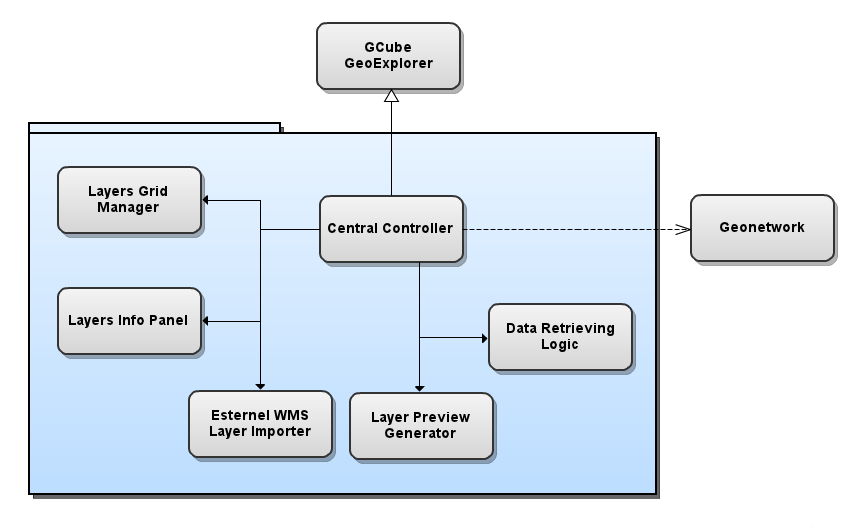Difference between revisions of "Geo Explorer"
m (→Overview) |
|||
| (3 intermediate revisions by 2 users not shown) | |||
| Line 1: | Line 1: | ||
| + | [[Category: gCube Spatial Data Infrastructure]] | ||
| + | |||
{| align="right" | {| align="right" | ||
||__TOC__ | ||__TOC__ | ||
| Line 9: | Line 11: | ||
== Overview == | == Overview == | ||
| − | The main objective of this application is to offer centralized environment for access to the entire spatial data in a certain scope. By external visual components, as [ | + | The main objective of this application is to offer centralized environment for access to the entire spatial data in a certain scope. By external visual components, as [[Gis_Viewer | GisViewer]] it's also possible to explore and analyze a personal set of selected resources. |
The service is able to interface to other infrastructural services in order to expand the number of functionalities and applications to the data under analysis. | The service is able to interface to other infrastructural services in order to expand the number of functionalities and applications to the data under analysis. | ||
| − | === Key features === | + | <!-- === Key features === |
| − | <font color=red>TO BE COMPLETE</font> | + | <font color=red>TO BE COMPLETE</font> --> |
== Design == | == Design == | ||
| Line 46: | Line 48: | ||
A diagram of the relationships between these components is reported in the following figure: | A diagram of the relationships between these components is reported in the following figure: | ||
| − | [[Image: | + | [[Image:geoExplorerDiagram.png|frame|center|GeoExplorer, internal and external architecture]] |
== Deployment == | == Deployment == | ||
All the components of the service must be deployed together in a single node. This subsystem can be replicated on multiple hosts and scopes, this does not guarantee a performance improvement because it is a management system for a single input dataset. | All the components of the service must be deployed together in a single node. This subsystem can be replicated on multiple hosts and scopes, this does not guarantee a performance improvement because it is a management system for a single input dataset. | ||
| − | |||
| − | |||
| − | |||
| − | |||
| − | |||
| − | |||
== Use Cases == | == Use Cases == | ||
Latest revision as of 13:23, 6 July 2016
GeoExplorer is a web application that allows users to navigate, organize, search and discovery internal or external layers.
This document outlines the design rationale, key features, and high-level architecture, as well as the deployment context.
Overview
The main objective of this application is to offer centralized environment for access to the entire spatial data in a certain scope. By external visual components, as GisViewer it's also possible to explore and analyze a personal set of selected resources.
The service is able to interface to other infrastructural services in order to expand the number of functionalities and applications to the data under analysis.
Design
Philosophy
GeoExplorer is based on Visual Information-Seeking Mantra, which is an approach to summarize the best user-interations order to get some information from a visual application: Overview first, Zoom and filter, Details on demand.
The application use a cloud network of geospatial resources called Geonetwork, these resources are tipically Geoserver Layers. It's still possible to get external layers by their WMS representation.
Architecture
The subsystem comprises the following components:
- GeoExplorer Central Controller: manage all the internal components and their interactions;
- Layers Grid Manager: a set of objects and widgets that allows layers discovering by a grid;
- Layer Info Panel: widget that show all layer info (details on demand);
- External WMS Layer Importer: a set of objects for import an external WMS layer;
- Layer Preview Generator: an utility for obtain a preview image of a layer;
- Data Retrieving Logic : a set of object that manage data filter, paging and ordering, exploiting the Geonetwork OGC Catalog Service for the Web (CSW);
- GCube GeoExplorer : an external wrapper which interact with some GCube components (such ASL, Workspace Light Tree, and so on).
A diagram of the relationships between these components is reported in the following figure:
Deployment
All the components of the service must be deployed together in a single node. This subsystem can be replicated on multiple hosts and scopes, this does not guarantee a performance improvement because it is a management system for a single input dataset.
Use Cases
Well suited Use Cases
The subsystem is particularly suited when experiment have to be performed on occurrence points referring to a certain species or family. The set of operations which can be applied, even lying on state-of-the-art and general purpose algorithms, have been studied and developed for managing such kind of information.
